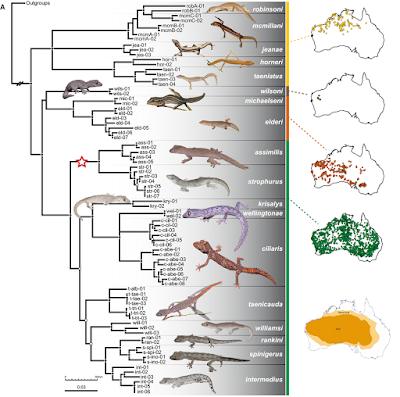 |
| Figure 1. (A) Phylogenetic reconstruction of Strophurus species-level relationships with representative photographs of each species in life (size standardized), as well as maps of the geographic distributions of the four major clades and a general map indicating the modern extent of the Australian arid zone. A solid, black circle indicates nodal support values ≥70% for maximum likelihood bootstraps (BS) and ≥0.95 for Bayesian inference posterior probabilities (PP). A white circle represents PP ≥0.95, but BS <70%.
DOI: 10.1111/zsc.12181
|
Abstract
The geckos in the genus Strophurus (Diplodactylidae) are one of only two squamate lineages with specialized caudal defensive glands. Many species in this genus also have distinctive caudal ornamentation combined with bright and/or contrasting colour pattern elements on the iris, tail and especially the lining of the mouth that are hypothesized to be adaptations for specialized (e.g. deimatic) defensive functions. We present the first multilocus, phylogenetic analysis of the biogeography and evolution of all recognized taxa of Strophurus. Contrary to previous phenotypic and ecological assessments, our phylogenetic analyses delineate four divergent lineages. Three lineages are relatively small (snout-vent length [SVL] 40–60 mm), species-poor (<5 recognized taxa), cryptically coloured (either striped or spotted) and lack precloacal pores (a secondary sexual trait) and putative deimatic elements. In contrast, the remaining lineage is comparatively species rich (at least 14 taxa), attains a larger body size (SVL 60–90 mm), possesses precloacal pores and shows extensive variation in caudal ornamentation and often bright and/or contrasting eye, tail and mouth colouration. The three less diverse lineages have smaller distributions and tend to be associated with spinifex (e.g. Triodia) hummock grasses or rocks, whereas the fourth lineage is much more widespread (including multiple biomes) and consistently reported to utilize more exposed diurnal microhabitats on shrubs and trees. Biogeographical analyses also indicate that – in contrast to many other Australian radiations – the arid biome is the ancestral area of occupation for Strophurus, with multiple inferred shifts into surrounding sclerophyll and monsoon biomes. This study emphasizes that – independent of caudal defensive glands – it appears to be a shift in microhabitat use that correlates with the accumulation of bright and contrasting colouration elements, secondary sexual characters and the widest geographic distribution.
Conclusions
Our phylogenetic analyses delineate four eco-morphologically divergent lineages within the chemically defended Australian gecko genus Strophurus that show differing patterns of taxonomic diversity. The three less diverse lineages generally lacking putative deimatic colour elements tend to be associated with spinifex hummock grasses or rocks, while the fourth lineage is consistently reported to utilize more exposed diurnal microhabitats on shrubs and trees. Thus, we suggest that it is this shift in microhabitat use that correlates with an accumulation of bright and contrasting colour elements, the possession of secondary sexual characters, and an extensive geographic distribution.Stuart V. Nielsen, Paul M. Oliver, Rebecca J. Laver, Aaron M. Bauer and Brice P. Noonan. 2016. Stripes, Jewels and Spines: Further Investigations Into the Evolution of Defensive Strategies in A Chemically Defended Gecko Radiation (Strophurus, Diplodactylidae). Zoologica Scripta. 45(5); 481–493. DOI: 10.1111/zsc.12181
ResearchGate.net/publication/303376643_Stripes_jewels_and_spines_Further_investigations_into_the_evolution_of_defensive_strategies_in_a_chemically_defended_gecko_radiation_Strophurus_Diplodactylidae

